Research on the Application of Atmospheric Motion Vector from MetOp Satellite Series in CMA-GFS
Highlights
- This study has developed assimilation techniques encompassing quality control and thinning schemes for MetOp-Dual, MetOp-B and MetOp-C based on CMA-GFS (China Meteorological Administration Global Forecast System), which fills the gap in the application of such data in CMA-GFS.
- MetOp AMV products, through quality control and thinning, have increased the AMVs in CMA-GFS by 25%. By effectively reducing the observational gaps in polar and oceanic areas, the one-month assimilation experiment of MetOp AMV improves CMA-GFS's backgrounds (particularly the polar and high-latitude regions) and advances the usable forecast lead time for global 500 hPa geopotential height by 0.22 days.
- This study, for the first time, applies MetOp-Dual, MetOp-B and MetOp-C products in CMA-GFS, which significantly promotes the AMV data utilization rate in CMA-GFS.
- The one-month assimilation experiment of MetOp AMV products significantly improves the model background and forecasting performance of the CMA-GFS, which implies the MetOp AMV products can play a positive role in promoting the forecast performance of the operational CMA-GFS in the long run.
Abstract
1. Introduction
2. Materials and Methods
2.1. Data
- Target extraction;
- Tracking;
- Height assignment;
- Derivation of the final vector;
- Automatic quality control (AQC).
2.2. Methods
- Control Experiment: Based on CMA-GFS4.2, all currently operational data are assimilated, including ground in situ observations, radiosonde data, aircraft reports, radio occultation data, and satellite radiance data, to run cyclic assimilation and forecast from 15 June to 1 August 2024. The driving data were from NCEP (short for National Centers for Environmental Prediction) Global Data Assimilation System Final Operational Analysis (FNL).
- Sensitivity Experiment: The settings are the same as those in the Control Experiment, except that MetOp-Dual, MetOp-B, and MetOp-C AMV data are added to the assimilation.
3. Preprocessing of MetOp Series AMVs Before Assimilation
3.1. Quality Assessment and Quality Control
3.2. Spatial Thinning Scheme
4. Impact of MetOp Series AMVs on the Backgrounds and Forecasts of CMA-GFS
4.1. Increase in Assimilated Data Volume
4.2. Observation Space Verification
4.3. Model Space Verification
4.4. Forecast Result Analysis
5. Conclusions
- Quality Control and Thinning Processing Schemes: A quality control protocol is developed to retain MetOp AMVs with confidence levels exceeding 80%, altitudes below 200 hPa, and horizontal wind speeds under 30 m/s. Additionally, a three-dimensional thinning scheme was implemented with 200 km horizontal and 50 hPa vertical intervals. These measures increased CMA-GFS’s total AMV observations by 25%, with MetOp AMVs accounting for 41.1% of mid-tropospheric (500–600 hPa) AMV data and over 80% of AMV data in polar mid-levels. These preprocessing measures enhanced the utilization of MetOp AMVs and helped fill observational gaps, particularly in data-sparse regions like the polar areas and the mid-troposphere.
- Background Field Improvements: Observation space and model space validations demonstrated that MetOp AMVs generally improved CMA-GFS’s global background fields by: (a) bringing observation equivalents closer to direct measurements (e.g., radiosondes, aircraft reports, and radiance data), and (b) producing a more stable and accurate analysis field that aligns closely with ERA5 reanalysis. These improvements are most pronounced in polar and mid- to high-latitude regions. Notably, standard deviations of 500–700 hPa zonal wind (U) relative to ERA5 in the Arctic decreased by up to 4.6% after assimilating MetOp AMVs.
- Forecast Performance Enhancements: Forecast experiments revealed consistent improvements in CMA-GFS forecast fields, particularly for short-range (0–3 day) predictions across multiple variables. Anomaly Correlation Coefficient (ACC) analysis indicated a 0.22-day increase in the usable forecast days for global 500 hPa geopotential height fields.
Author Contributions
Funding
Data Availability Statement
Acknowledgments
Conflicts of Interest
References
- Velden, C.S.; Hayden, C.M.; Nieman, S.J.W.; Paul Menzel, W.; Wanzong, S.; Goerss, J.S. Upper-tropospheric winds derived from geostationary satellite water vapor observations. Bull. Am. Meteorol. Soc. 1997, 78, 173–195. [Google Scholar] [CrossRef]
- Tomassini, M.; Kelly, G.; Saunders, R. Use and impact of satellite atmospheric motion winds on ECMWF analyses and forecasts. Mon. Weather. Rev. 1999, 127, 971–986. [Google Scholar] [CrossRef]
- Forsythe, M. Atmospheric motion vectors: Past, present and future. In Proceedings of the ECMWF Annual Seminar, Exeter, UK, 4–8 September 2007; pp. 1–79. [Google Scholar]
- Berger, H.; Langland, R.; Velden, C.S.; Reynolds, C.A.; Pauley, P.M. Impact of enhancedsatellite-derived atmospheric motion vector observations on numerical tropical cyclone track forecasts in the western north Pacific dur-ing TPARC/TCS-08. J. Appl. Meteorol. Climatol. 2011, 50, 2309–2318. [Google Scholar] [CrossRef]
- Zhou, R.D.; Xia, P.; Zhang, X.H.; Xu, N.; Min, M. Research progress and prospects of atmospheric motion vector based on meteorological satellite images. Rev. Geophys. Planet. Phys. 2024, 55, 184–194. (In Chinese) [Google Scholar] [CrossRef]
- Li, J.; Santek, D.; Li, Z.; Lim, A.; Di, D.; Min, M.; Velden, C.; Menzel, W.P. Tracking Atmospheric Motions for Obtaining Wind Estimates Using Satellite Observations—From 2D to 3D. Bull. Amer. Meteor. Soc. 2025, 106, E344–E363. [Google Scholar] [CrossRef]
- Eyre, J.R.; English, S.J.; Forsythe, M. Assimilation of satellite data in numerical weather prediction. Part I: The early years. Q. J. R. Meteorol. Soc. 2020, 146, 49–68. [Google Scholar] [CrossRef]
- Holmlund, K. The atmospheric motion vector retrieval scheme for meteosat second generation. In Proceedings of the Fifth Internationial Winds Workshop, Lorne, Australia, 28 February–3 March 2000; pp. 201–208. [Google Scholar]
- Zhao, J.; Gao, J.; Jones, T.A.; Hu, J. Impact of assimilating high-resolution atmospheric motion vectors on convective scale short-term forecasts: 2. Assimilation experiments of GOES-16 satellite derived winds. J. Adv. Model. Earth Syst. 2021, 13, e2021MS002486. [Google Scholar] [CrossRef]
- Kim, D.H.; Kim, H.M. Effect of assimilating Himawari-8 atmospheric motion vectors on forecast errors over East Asia. J. Atmos. Ocean. Technol. 2018, 35, 1737–1752. [Google Scholar] [CrossRef]
- Chen, Y.; Shen, J.; Fan, S.; Meng, D.; Wang, C. Characteristics of Fengyun-4A satellite atmospheric motion vectors and their impacts on data assimilation. Adv. Atmos. Sci. 2020, 37, 1222–1238. [Google Scholar] [CrossRef]
- Hautecoeur, O.; Borde, R. Derivation of wind vectors from AVHRR/MetOp at EUMETSAT. J. Atmos. Ocean. Technol. 2017, 34, 1645–1659. [Google Scholar] [CrossRef]
- ECMWF Assimilation Observation Monitoring Website. Available online: https://charts.ecmwf.int/catalogue/packages/obstat/?facets=%7B%22Parameter%22%3A%5B%5D%2C%22Data%20type%22%3A%5B%22Atmospheric%20Motion%20Vectors%22%5D%2C%22Category%22%3A%5B%22Satellite%20Data%22%5D%2C%22Instrument%22%3A%5B%22METOP-B%22%2C%22METOP-C%22%2C%22DUAL_METOP%22%5D%7D (accessed on 21 August 2025).
- AMV Activities and Progress at the Meteorological Service of Canada. Available online: https://cgms-info.org/html/iww14/talks/06_Posters/IWW14_Laroche_Poster.pdf (accessed on 21 August 2025).
- Upgrades of Polar AMVs Use in JMA’s Global NWP System. Available online: https://www.ssec.wisc.edu/meetings/iwwg/2023-meeting/presentations/upgrades-of-polar-amvs-use-in-jmas-global-nwp-system/ (accessed on 21 August 2025).
- Xiong, X.; Che, N.; Barnes, W. Terra MODIS on-orbit spatial characterization and performance. IEEE Trans. Geosci. Remote Sens. 2005, 43, 355–365. [Google Scholar] [CrossRef]
- NWP SAF AMV Monitoring: The 10th Analysis Report (AR10). Available online: https://cgms-info.org/wp-content/uploads/2024/08/nwpsaf_mo_tr_042.pdf (accessed on 21 August 2025).
- Daily SATOB Monitoring of METEO FRANCE. Available online: http://www.meteo.fr/special/minisites/monitoring/SATELLITE/SATOB/satob.html (accessed on 21 August 2025).
- Xue, J.; Zhuang, S.; Zhu, G.; Zhang, H.; Liu, Z.; Liu, Y.; Zhuang, Z. Scientific design and preliminary results of three-dimensional variational data assimilation system of GRAPES. Chin. Sci. Bull. 2008, 53, 3446–3457. [Google Scholar] [CrossRef]
- Yan, L.; Jishan, X.; Lin, Z.; Huijuan, L. Verification and Diagnostics for Data Assimilation System of Global GRAPES. J. Appl. Meteorol. Sci. 2016, 27, 1–15. [Google Scholar]
- Han, W.; Xue, J.S.; Xu, J.M.; Zhang, Q.S. Assimilation of FY2C AMV in GRAPES. In Proceedings of the Eighth International Winds Workshop, Beijing, China, 24–28 April 2006; EUMETSAT: Beijing, China, 2006; pp. 24–28. [Google Scholar]
- Wan, X.M.; Tian, W.H.; Han, W.; Wang, R.W.; Zhang, Q.S.; Zhang, X.H. The evaluation of FY-2E reprocessed IR AMVs in GRAPES. Meteorol. Mon. 2017, 43, 1–10. (In Chinese) [Google Scholar]
- Wan, X.; Gong, J.; Han, W. The Evaluation of FY-4A AMVs in GRAPES_RAFS. Meteorol. Mon. 2019, 45, 458–468. [Google Scholar] [CrossRef]
- Wan, X.; Han, W.; Tian, W.; He, X. The application of intensive FY-2G AMVs in GRAPES_RAFS. Plateau Meteorol. 2018, 37, 1083–1093. (In Chinese) [Google Scholar]
- Shen, X.; Su, Y.; Hu, J.; Wang, J.; Sun, J.; Xue, J.; Han, W.; Zhang, H.; Lu, H.; Zhang, H. Development and operation transformation of GRAPES globalmiddle-range forecast system. J. Appl. Meteorol. Sci. 2017, 28, 1–10. (In Chinese) [Google Scholar]
- Shen, X.S.; Wang, J.J.; Li, Z.C.; Chen, D.H.; Gong, J.D. China’s independent and innovative development of numerical weather prediction. Acta Meteorol. Sin. 2020, 78, 451–476. [Google Scholar]
- Zhang, W.; Shen, X.; Cao, X.; Sun, J.; Wu, J.; Peng, J.; Song, J.; Zhu, X.; Wang, J.; Zhang, Z. 70 years of development in China’s operational numerical weather prediction. Acta Meteorol. Sin. 2025, 83, 435–463. [Google Scholar] [CrossRef]
- Bormann, N.; Saarinen, S.; Kelly, G.; Thépaut, J.-N. The Spatial Structure of Observation Errors in Atmospheric Motion Vectors from Geostationary Satellite Data. Mon. Weather. Rev. 2003, 131, 706–718. [Google Scholar] [CrossRef]
- Zhou, L.; Divakarla, M.; Liu, X.; Layns, A.; Goldberg, M. An overview of the science performances and calibration/validation of joint polar satellite system operational products. Remote Sens. 2019, 11, 698. [Google Scholar] [CrossRef]
- Hersbach, H.; Bell, B.; Berrisford, P.; Hirahara, S.; Horányi, A.; Muñoz-Sabater, J.; Nicolas, J.; Peubey, C.; Radu, R.; Schepers, D.; et al. The ERA5 global reanalysis. Q. J. R. Meteorol. Soc. 2020, 146, 1999–2049. [Google Scholar] [CrossRef]
- Zhang, J.; Sun, J.; Shen, X.; Su, Y.; Ma, Z.; Jing, H.; Liu, Q.; Zhang, H.; Jiang, Q.; Chen, F. Key model technologies of CMA-GFS V4.0 and application to operational forecast. J. Appl. Meteorol. Sci. 2023, 34, 513–526. [Google Scholar] [CrossRef]
- Zhu, G. Interpretation of Several Basic Aspects of Atmospheric Data Assimilation. Meteorol. Mon. 2015, 41, 997–1006. (In Chinese) [Google Scholar] [CrossRef]
- Warrick, F.; Lean, K. Wind information from Satellites: Atmospheric Motion Vectors Passive Tracing with GEO Radiances; ECMWF: Barbour, AL, USA, 2025. [Google Scholar]
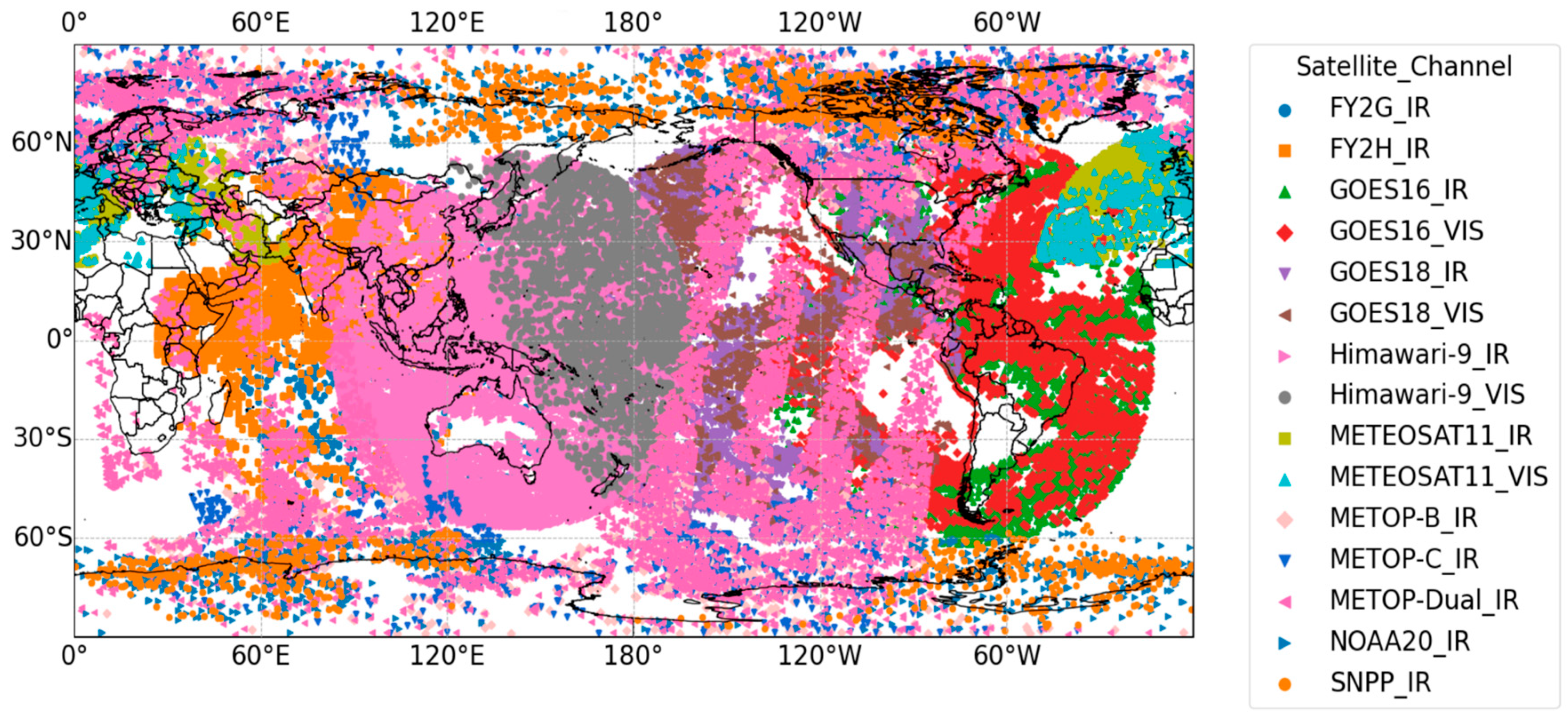


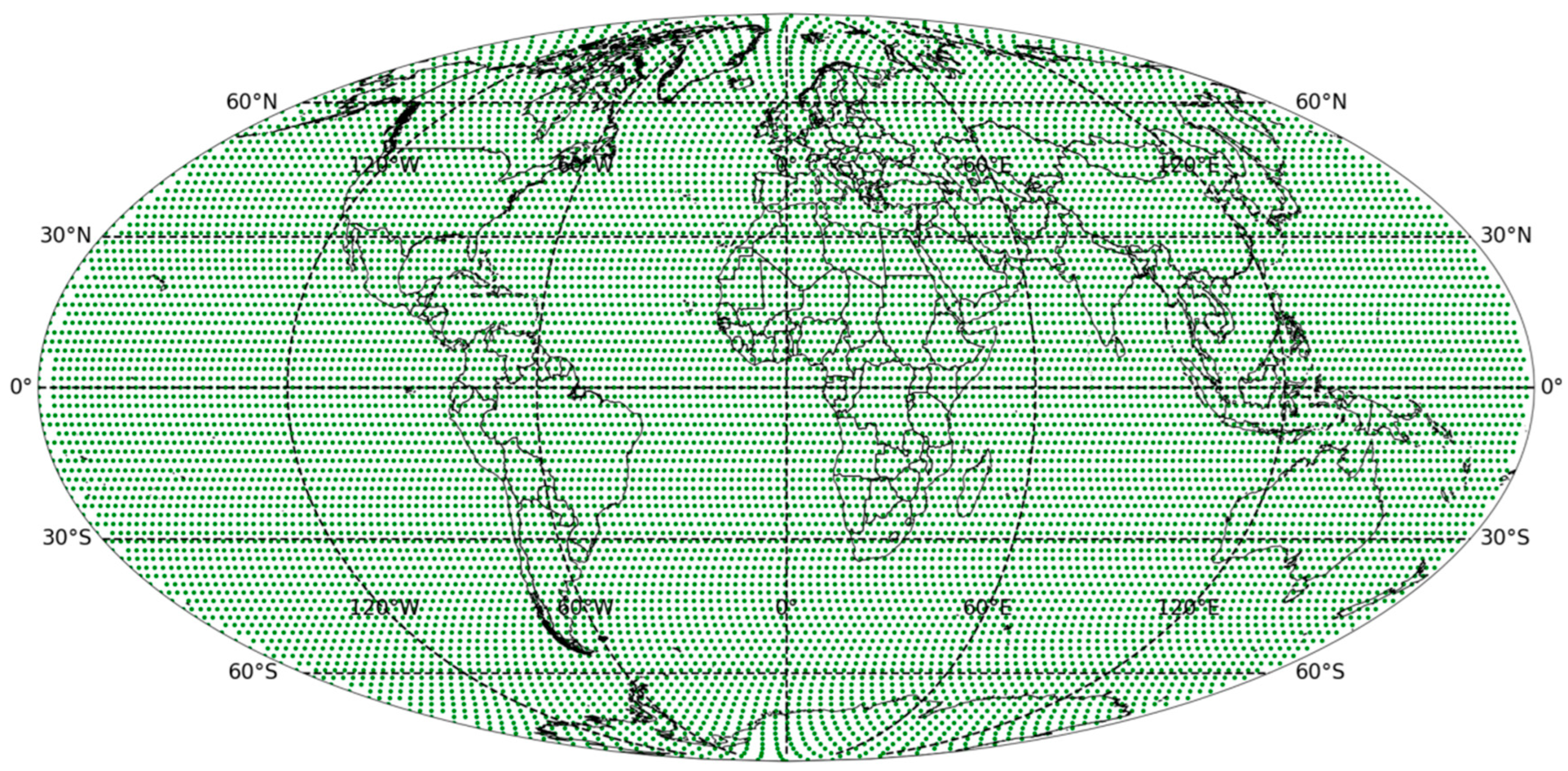


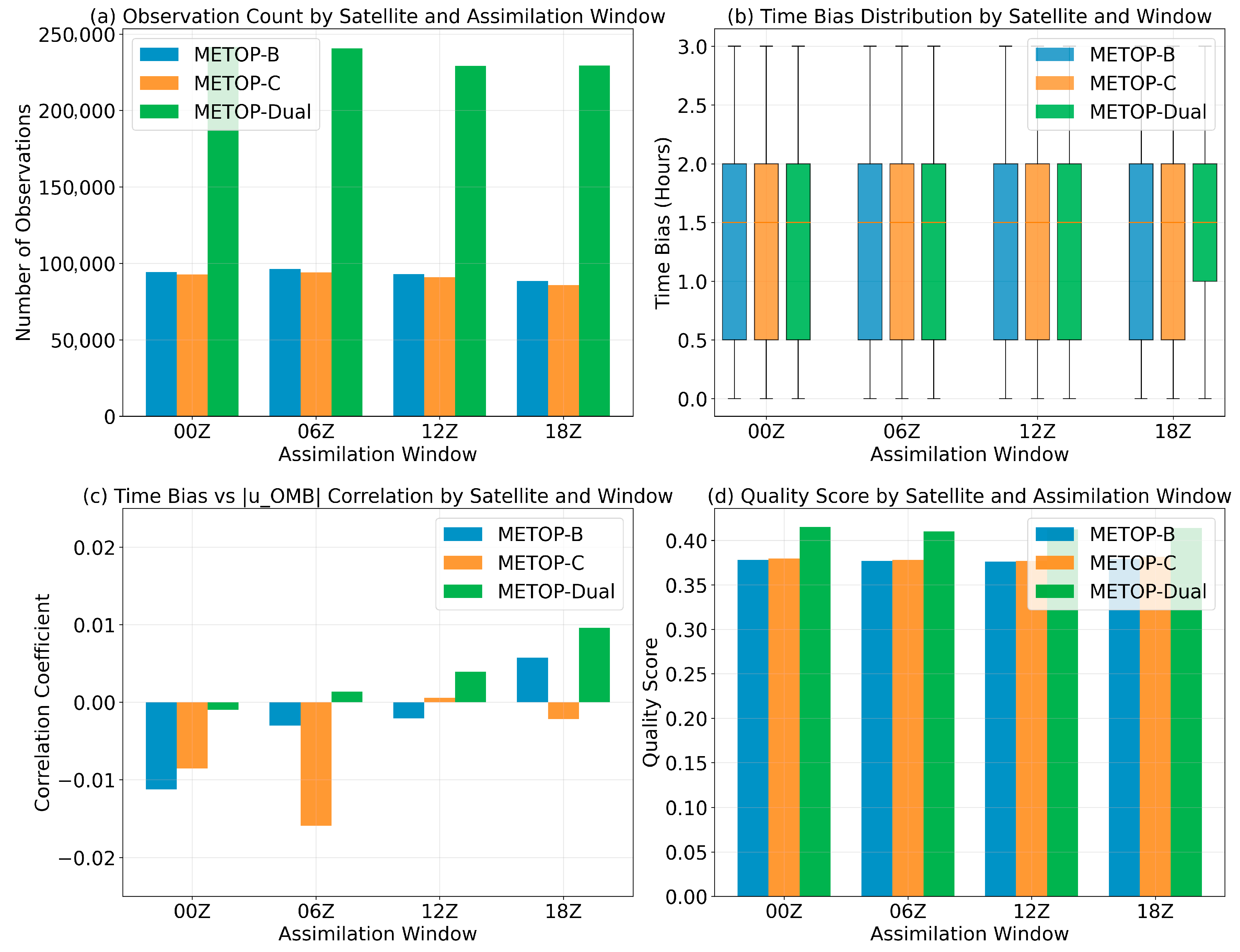
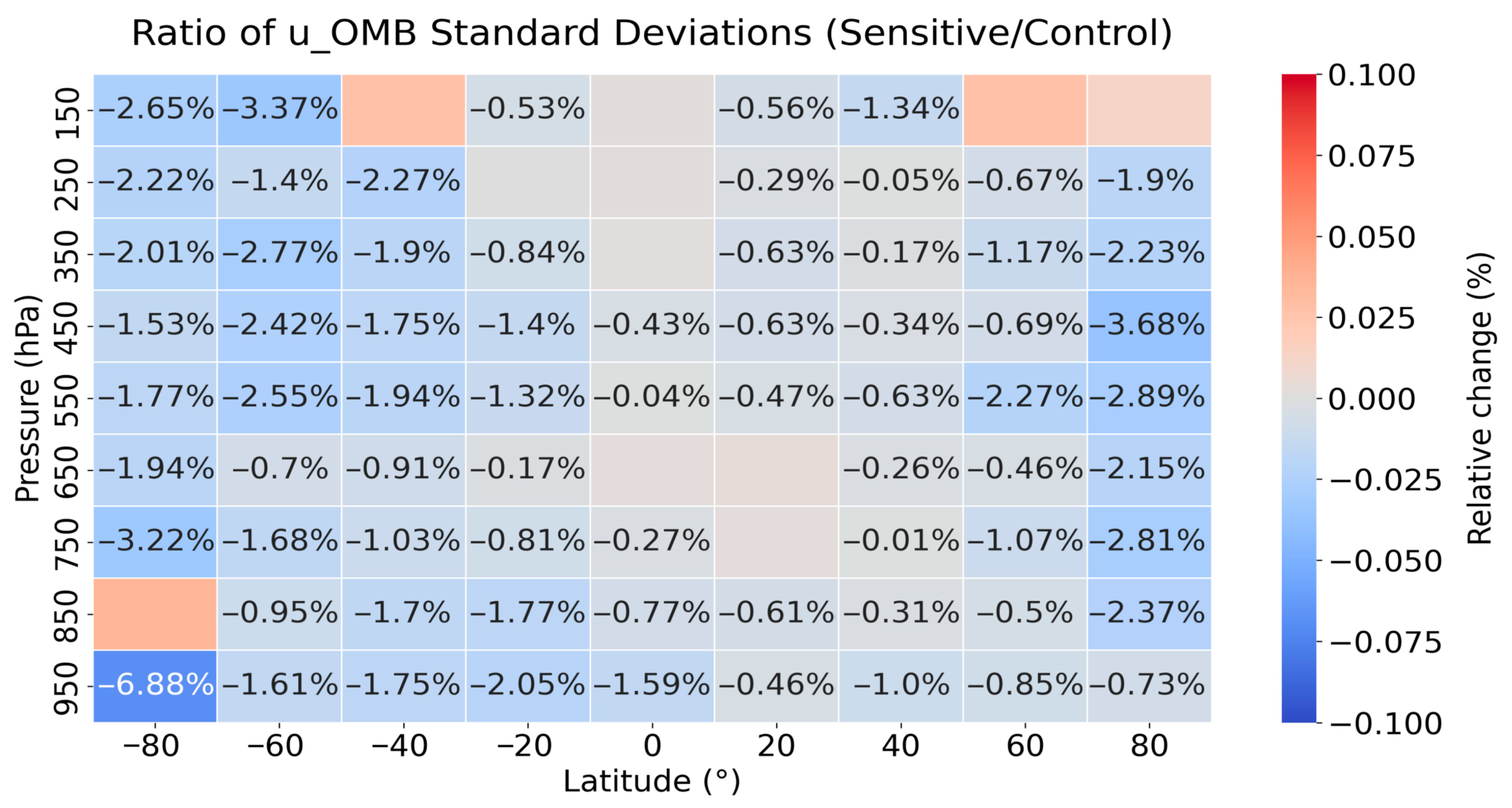
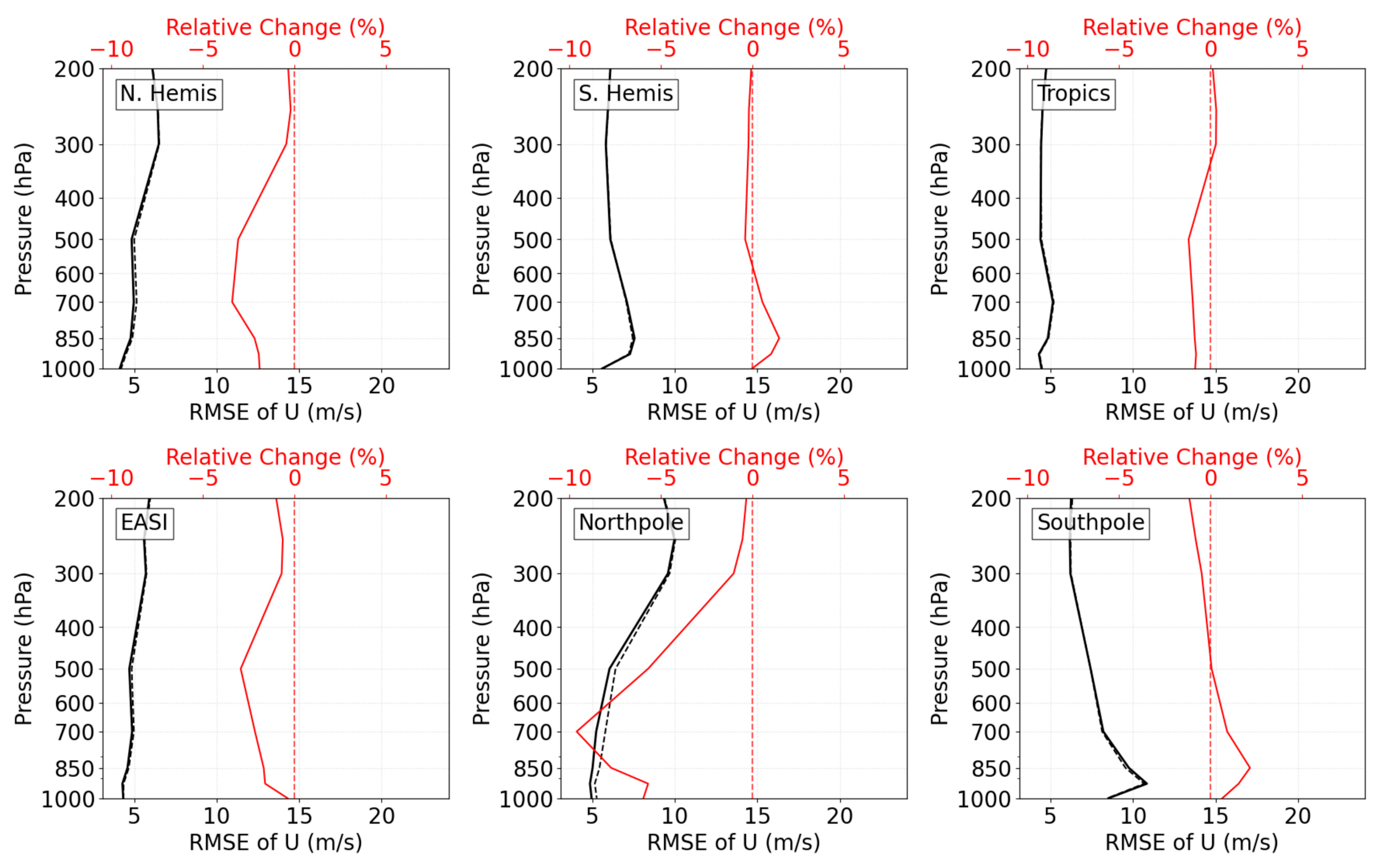
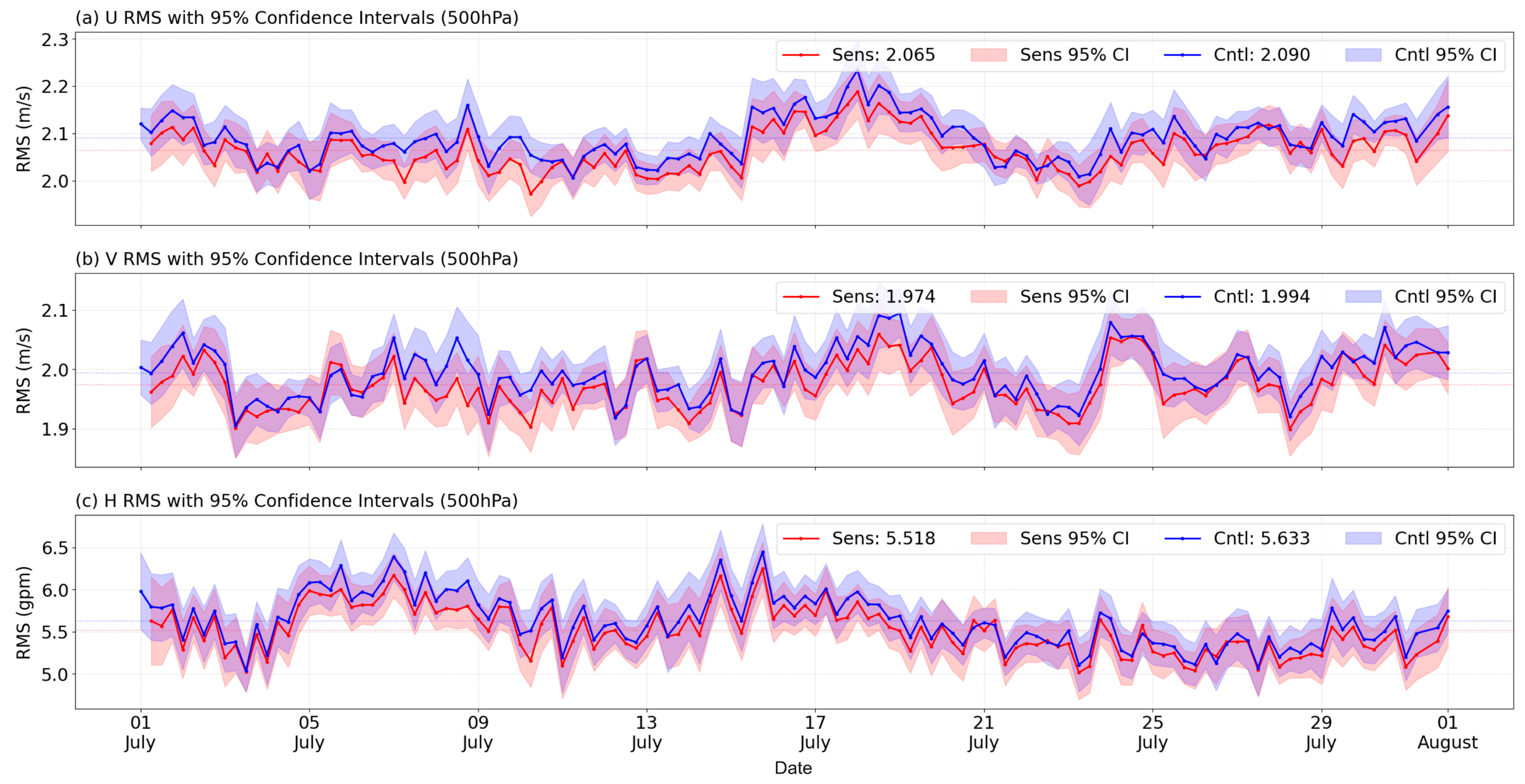
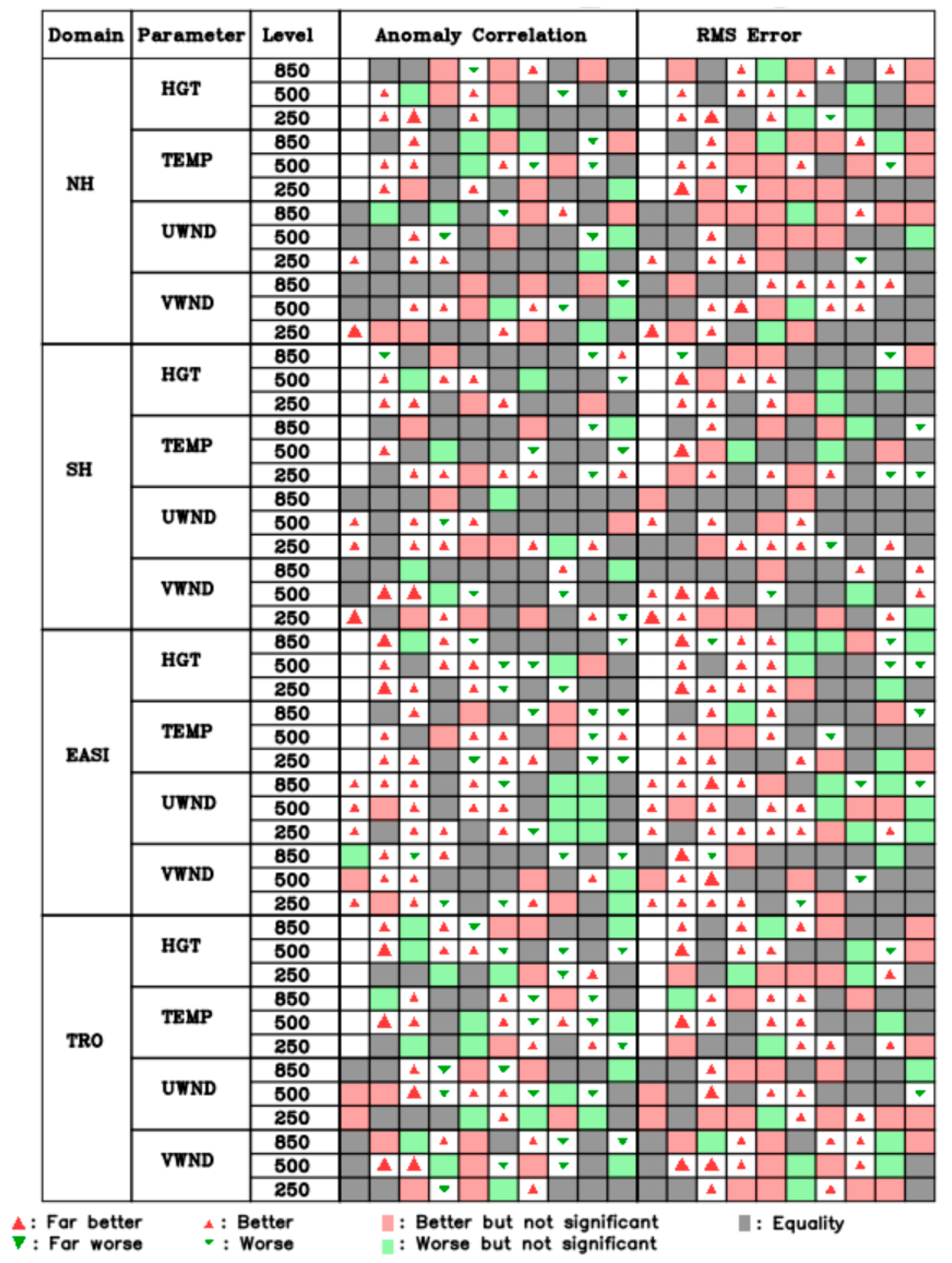
| Data Type | Variable | O-B Std | ||
|---|---|---|---|---|
| Control Experiment | Sensitivity Experiment | Sensitivity/Control | ||
| Radiosonde | U (m/s) | 2.773 | 2.757 | 0.9942 |
| V (m/s) | 2.687 | 2.668 | 0.9929 | |
| Surface Observation | Surface Pressure (hPa) | 0.7366 | 0.7115 | 0.9659 |
| Aircraft Report | U (m/s) | 2.3346 | 2.3236 | 0.9953 |
| Tem (K) | 1.0258 | 1.0241 | 0.9983 | |
| NOAA20 ATMS (Advanced Technology Microwave Sounder) | Brightness Temperature (K) | 0.7883 | 0.7743 | 0.9822 |
| AMV (Satellite_Channel, IR: Infrared, VIS: Visible) | GOES16_IR | 2.7346 | 2.712 | 0.9917 |
| GOES16_VIS | 1.9444 | 1.9302 | 0.9927 | |
| Himawari-9_IR | 2.4373 | 2.4136 | 0.9903 | |
| Himawari-9_VIS | 2.1434 | 2.126 | 0.9919 | |
| METEOSAT11_IR | 3.8744 | 3.8636 | 0.9972 | |
| METEOSAT11_VIS | 2.1572 | 2.1545 | 0.9987 | |
| NOAA20_IR | 3.2311 | 3.1538 | 0.9761 | |
| SNPP_IR | 3.2571 | 3.1907 | 0.9796 | |
Disclaimer/Publisher’s Note: The statements, opinions and data contained in all publications are solely those of the individual author(s) and contributor(s) and not of MDPI and/or the editor(s). MDPI and/or the editor(s) disclaim responsibility for any injury to people or property resulting from any ideas, methods, instructions or products referred to in the content. |
© 2025 by the authors. Licensee MDPI, Basel, Switzerland. This article is an open access article distributed under the terms and conditions of the Creative Commons Attribution (CC BY) license (https://creativecommons.org/licenses/by/4.0/).
Share and Cite
Ma, J.; Liu, Y.; Wan, X. Research on the Application of Atmospheric Motion Vector from MetOp Satellite Series in CMA-GFS. Remote Sens. 2025, 17, 3519. https://doi.org/10.3390/rs17213519
Ma J, Liu Y, Wan X. Research on the Application of Atmospheric Motion Vector from MetOp Satellite Series in CMA-GFS. Remote Sensing. 2025; 17(21):3519. https://doi.org/10.3390/rs17213519
Chicago/Turabian StyleMa, Jiali, Yan Liu, and Xiaomin Wan. 2025. "Research on the Application of Atmospheric Motion Vector from MetOp Satellite Series in CMA-GFS" Remote Sensing 17, no. 21: 3519. https://doi.org/10.3390/rs17213519
APA StyleMa, J., Liu, Y., & Wan, X. (2025). Research on the Application of Atmospheric Motion Vector from MetOp Satellite Series in CMA-GFS. Remote Sensing, 17(21), 3519. https://doi.org/10.3390/rs17213519






